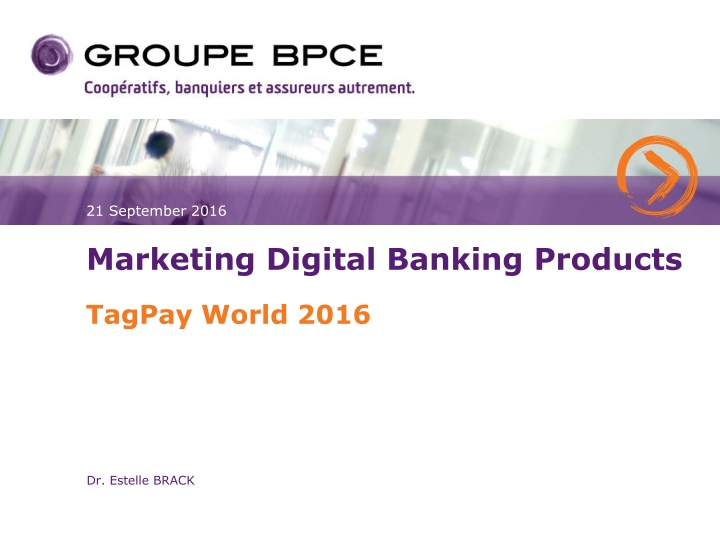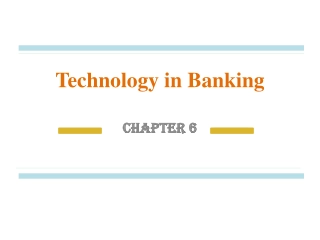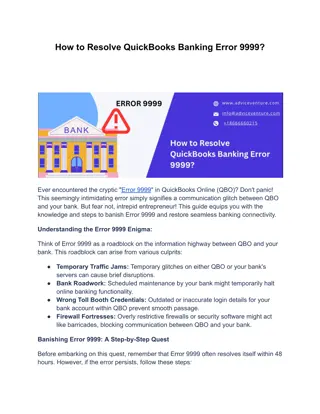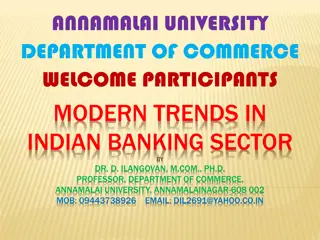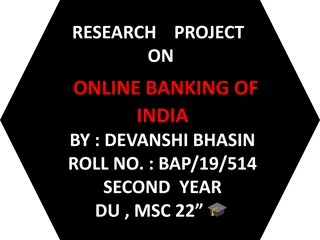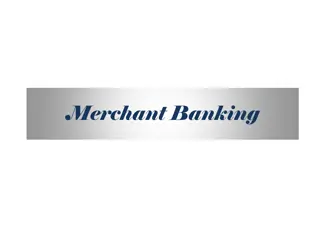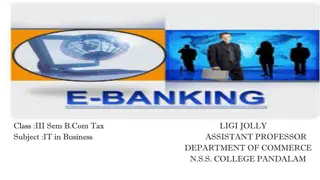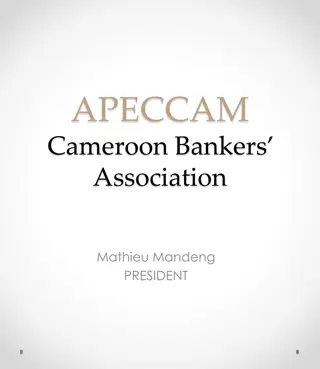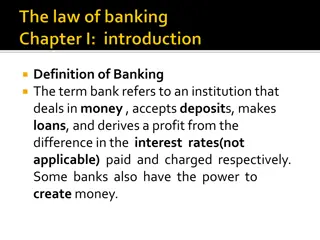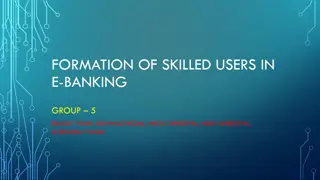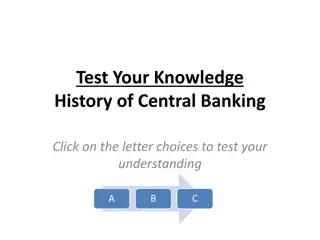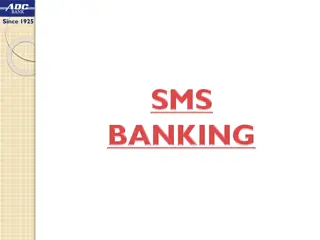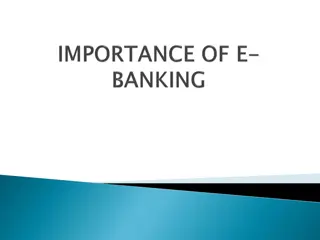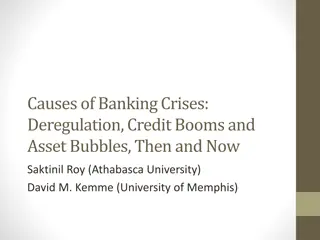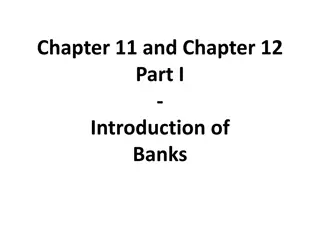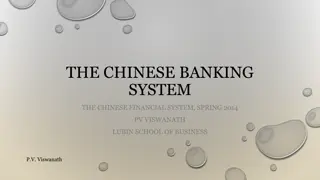Digital Banking Evolution: Historical Perspectives & Future Trends
The evolution of digital banking from traditional to modern practices, the impact of technology advancements, the role of central institutions in electronic payments, and the shift towards digital-centric strategies in banking. Explore the adoption of new technologies by large banks, the need for agile IT architecture, and the integration of innovative solutions for future growth in the banking sector.
Download Presentation

Please find below an Image/Link to download the presentation.
The content on the website is provided AS IS for your information and personal use only. It may not be sold, licensed, or shared on other websites without obtaining consent from the author.If you encounter any issues during the download, it is possible that the publisher has removed the file from their server.
You are allowed to download the files provided on this website for personal or commercial use, subject to the condition that they are used lawfully. All files are the property of their respective owners.
The content on the website is provided AS IS for your information and personal use only. It may not be sold, licensed, or shared on other websites without obtaining consent from the author.
E N D
Presentation Transcript
21 September 2016 Marketing Digital Banking Products TagPay World 2016 Dr. Estelle BRACK
1. Some historical perspctives Banking and Technology : an old and special story > The banking industry benefited and promoted in the same time IT advances since the 70ies > Technological progress has likely increased the productivity and scale economies associated with this technology The data are now transmitted to / disseminated from information exchanges electronically, and improved financial models are used to analyze the data to predict future credit problems. Front office technologies > Switch from paper payments to electronic payments by the population (cash/checks to debit/credit cards and electronic wallets) > ATM network > Internet / Mobile banking Back office technologies > Electronic payments technologies > Clearing and settlement > International Trade / CBK > Risks / AML / Accounting / Reporting, etc. 2 21/09/2016 MARKETING DIGITAL BANKING PRODUCTS
1. Some historical perspctives Central institutions > Electronic payments processing at the Central Bank level IT improvements in back-office processing of electronic payments resulted in productivity gains and scale economies that reduced costs dramatically over time. For example, the raw data on ACH at the US Federal Reserve* showed a decline in nominal unit costs from $0.869 per item processed to $0.176 over the 1990-2000 interval. > Information exchanges The technology of information exchanges has been shown to add value : credit bureaus, associations organized by banks, or public credit registers organized by central banks. > Generalization to the private banking sector Because all processors have access to the same technologies Because the Central Bank is required to simulate the behavior of a private-sector competitor by keeping costs under control and set prices to recover costs. It seems is not necessary to have large banks to exploit these economies. Small banks can share some of these benefits by outsourcing to a large processor, such as the Central Bank, correspondent bank, or other large private-sector processor. Nonetheless, there may be differences by bank size in the use of these technologies, even when most of the processing is performed by a third party. o o o 3 21/09/2016 MARKETING DIGITAL BANKING PRODUCTS
2. Big versus Small ? Is Big still Beautiful? > Most of the important new technologies were generally adopted earlier by large firms than small firms Large banks have generally been first to adopt transactional Internet websites, use electronic payments technologies, ATMs, securitization and off-balance sheet financial activities, portfolio risk models for dealing with proposed Basle international capital standards, etc. > The cost of history As traditional big banks have been developing IT structures for some decades now, their activity relies on a very complex IT architecture To be agile and be able to follow the market trends, they need to rethink their strategies and even Think out of the Box > Their further digital developement relies more and more on integration of new solutions Banks are used to perpetual evolution : simply look at the banking activities two decades ago BPCE examples with S-Money, Le Pot Commun, Depopass, Fidor The BPCE strategy is Digital-Centric 4 21/09/2016 MARKETING DIGITAL BANKING PRODUCTS
2. Big versus Small ? How Beautiful is Small? > The tradition : research suggests that even when there are significant scale economies associated with back-office operations, small firms were often able to share in the benefits of technological progress. > The current Revolution : The global financial services sector is now open to new actors Thanks to EU regulation (PSP, etc.) Thanks to Internet / Mobile / Cloud Technologies Thanks to high innovative initiatives (Silicon Valley, Estonia, Asia, etc.) Thanks to the so far unsatisfied needs : Africa > A new perspective : the User Experience Leeds to a higher level of competition From a vertical to a horizontal perspective : the user has access to all possibilities in a globalized world Impact of transparency and information 5 21/09/2016 MARKETING DIGITAL BANKING PRODUCTS
3. Who wins? Coopetition Small entities need the Big Banks > Why the Banks are still essential stakeholders Trust Experience Customer base Access to the Authorities in a long lasting fruitful dialogue Information about the client Size / Economies of scale Big Banks need to cooperate with Smaller entities > New Digital products at a very low price Competing with the existing products within the Banks Creating new products better adressing the customer needs (TagPay) > Monoline products : one company one solution Simple banks (Compte Nickel, N26) International transfers (TransferWise, WesternUnion, WorldRemit, etc.) Aggregate accounts > => TagPay & Soci t G n rale 6 21/09/2016 MARKETING DIGITAL BANKING PRODUCTS
Thank you for your kind attention Dr. Estelle Brack Program Director for Payments @ BPCE Estelle.Brack@bpce.fr 7 21/09/2016 MARKETING DIGITAL BANKING PRODUCTS
